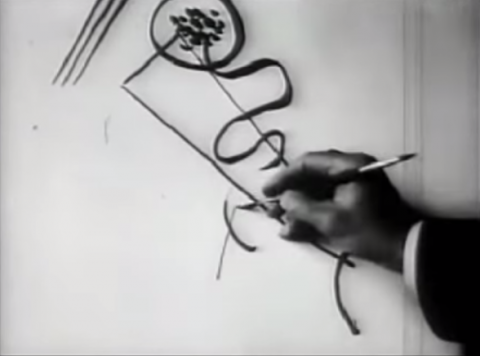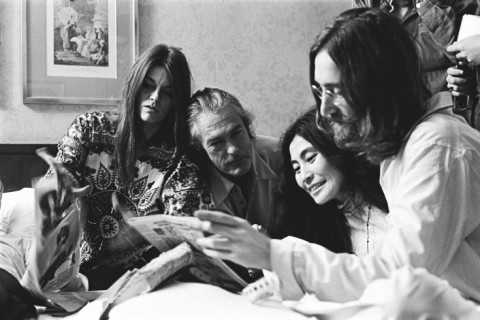German warplanes cross the sky. Explosions flash. Shell-shocked villagers stagger out of their damaged homes and begin to grieve. “Before,” says Ernest Hemingway in his flat Midwestern accent, “death came when you were old or sick. But now it comes to all this village. High in the sky and shining silver, it comes to all who have no place to run, no place to hide.”
The scene is from the 1937 film The Spanish Earth, an important visual document of the Spanish Civil War and a rare record of the famous writer’s voice. Hemingway went to Spain in the spring of 1937 to report on the war for the North American Newspaper Alliance (NANA), but spent a good deal of time working on the film. Before leaving America, he and a group of artists that included Archibald MacLeish, John Dos Passos and Lillian Hellman banded together to form Contemporary Historians, Inc., to produce a film to raise awareness and money for the Spanish Republican cause. The group came up with $18,000 in production money–$5,000 of it from Hemingway–and hired the Dutch documentary filmmaker Joris Ivens, a passionate leftist, to make the movie.
MacLeish and Ivens drafted a short outline for the story, with a theme of agrarian reform. It was MacLeish who came up with the title. The film, as they envisioned it, would tell the story of Spain’s revolutionary struggle through the experience of a single village. To do that, Ivens planned to stage a number of scenes. When he and cameraman John Fernhout (known as “Ferno”) arrived in Spain they decided to focus on the tiny hamlet of Fuentedueña de Tajo, southeast of Madrid, but they soon realized it would be impossible to set up elaborate historical re-enactments in a country at war. They kept the theme of agrarian struggle as a counterpoint to the war. When Dos Passos arrived in Fuentedueña, he encouraged that approach. “Our Dutch director,” wrote Dos Passos, “did agree with me that, instead of making the film purely a blood and guts picture we ought to find something being built for the future amid all the misery and massacre.”
That changed when Hemingway arrived. The friendship between the two writers was disintegrating at the time, so they didn’t work together on the project. It was agreed upon in advance that Hemingway would write the commentary for the film, but while in Spain he also helped Ivens and Fernhout navigate the dangers of the war zone. “Hemingway was a great help to the film crew,” writes Hans Schoots in Living Dangerously: A Biography of Joris Ivens. “With a flask of whisky and raw onions in his pockets, he lugged equipment and arranged transport. Ivens generally wore battle dress and a black beret. Hemingway went as far as a beret but otherwise stuck to civvies. Although he rarely wore glasses, he almost never took them off in Spain, clear evidence of the seriousness of their task.” In “Night Before Battle,” a short story based partially on his experience making the movie, Hemingway describes what it’s like filming in a place where the glint from your camera lens draws fire from enemy snipers:
At this time we were working in a shell-smashed house that overlooked the Casa del Campo in Madrid. Below us a battle was being fought. You could see it spread out below you and over the hills, could smell it, could taste the dust of it, and the noise of it was one great slithering sheet of rifle and automatic rifle fire rising and dropping, and in it came the crack of the guns and the bubbly rumbling of the outgoing shells fired from the batteries behind us, the thud of their bursts, and then the rolling yellow clouds of dust. But it was just too far to film well. We had tried working closer but they kept sniping at the camera and you could not work.
The big camera was the most expensive thing we had and if it was smashed we were through. We were making the film on almost nothing and all the money was in the cans of film and the cameras. We could not afford to waste film and you had to be awfully careful of the cameras.
The day before we had been sniped out of a good place to film from and I had to crawl back holding the small camera to my belly, trying to keep my head lower than my shoulders, hitching along on my elbows, the bullets whocking into the brick wall over my back and twice spurting dirt over me.
The Western front at Casa de Campo on the outskirts of Madrid was just a few minutes’ walk from the Florida Hotel, where the filmmakers were staying. Any doubt about whether the passage from “Night Before Battle” is autobiographical are dispelled in the following excerpt from one of Hemingway’s NANA dispatches, quoted by Schoots:
Just as we were congratulating ourselves on having such a splendid observation post and the non-existent danger, a bullet smacked against a corner of brick wall beside Ivens’s head. Thinking it was a stray, we moved over a little and, as I watched the action with glasses, shading them carefully, another came by my head. We changed our position to a spot where it was not so good observing and were shot at twice more. Joris thought Ferno had left his camera at our first post, and as I went back for it a bullet whacked into the wall above. I crawled back on my hands and knees, and another bullet came by as I crossed the exposed corner. We decided to set up the big telephoto camera. Ferno had gone back to find a healthier situation and chose the third floor of a ruined house where, in the shade of a balcony and with the camera camouflaged with old clothes we found in the house, we worked all afternoon and watched the battle.
In May, Ivens returned to New York to oversee the work of editor Helen van Dongen. Hemingway soon followed. When Ivens asked Hemingway to clarify the theme of the picture, according to Kenneth Lynn in his biography Hemingway, the writer supplied three sentences: “We gained the right to cultivate our land by democratic elections. Now the military cliques and absentee landlords attack to take our land from us again. But we fight for the right to irrigate and cultivate this Spanish Earth which the nobles kept idle for their own amusement.” (more…)



